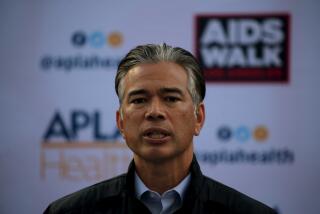Op-Ed: What’s best for doctors is best for patients? Maybe not.
In September 2013, just as Covered California was preparing to enroll a million new patients in the state’s healthcare system, the state Senate caved to pressure from the California Medical Assn. and voted down a bill that would empower nurse practitioners to see patients without supervision by a medical doctor. Last week, it corrected its error, passing a similar bill despite renewed opposition from the state doctors’ guild, which whined, as it has for years, that allowing nurse practitioners to operate independently would put patients at risk.
A guild protects its own. Its goal, whether it’s an association of medieval blacksmiths or of 21st century forensic accountants, is always the same: to keep its numbers low and its services expensive. Guilds have traditionally achieved this goal through “regulatory capture” — mandating an elaborate system of accreditation, for example, or requiring lengthy periods of apprenticeship.
The American Medical Assn., perhaps the most successful guild in American history, has done an exceptional job of serving its members. Notwithstanding a rough patch in the 1930s, when the Supreme Court found it guilty of violating the Sherman Antitrust Act, the AMA has held the line against socialized medicine (though it failed to stop Medicare), restricted the number of medical graduates and, until recently, fended off competition from the country’s 205,000 nurse practitioners, who threaten to undercut doctors by providing cheaper care.
The strength of the AMA and state-level doctors’ guilds can be measured in physician salaries, which are on average twice as large as in other advanced economies; and in American healthcare spending, which, as a fraction of the economy, is twice as high as the OECD average (despite lower rates of insurance coverage).
Doctors’ guilds have been able to achieve so much because they have managed to convince the public that “what’s good for doctors is good for patients.” Is that really the case? We don’t believe that “what’s good for prison guards is good for prisoners.” (And we’re starting to doubt that “what’s good for teachers is good for students.”) The enduring prestige of doctors over and above other professionals has been a persistent barrier to healthcare reform, a lesson Hillary Rodham Clinton learned in 1993 when the AMA helped torpedo HillaryCare.
This is not to say that accreditation has no role in medicine. No one wants a brain surgeon who’s an auto-didact, and the government has an interest in preventing quacks from selling potions. A YouTube tutorial is not a substitute for a degree. But nurse practitioners are not circus jugglers; they’re highly trained professionals who are perfectly capable of providing primary care. The doctors’ guilds don’t deny this — they just want to make sure that nurse practitioners are tethered to MDs and economically subservient to them. In some contexts, nurse practitioners must give their “supervising physician” between $1,000 and $2,000 monthly; in exchange, doctors fill out administrative forms and glance at charts.
The medical associations, though, may have finally overplayed their hand. After years of working to prevent a glut in doctors, they’ve created a physician shortage so dire that state legislatures, scrambling to meet the surge in demand for health services unleashed by the Affordable Care Act, now have no choice but to elevate nurse practitioners to cope with millions of new patients.
Allowing nurse practitioners to operate independently is not an entirely new development — sparsely populated states with large rural areas, such as Maine and Washington, have long had laws on the books empowering nurse practitioners. In the last two years, though, big states such as New York have begun to join their ranks, and though nurse practitioners still face hurdles in doctor strongholds such as Florida, Texas and Massachusetts, the trend is in their favor.
The California bill, like New York’s law, is incremental. It allows a nurse practitioner to operate without doctor supervision, but only if he or she is affiliated with a medical group; the California law doesn’t allow nurse practitioners to open their own shops.
There are legitimate concerns that, if the bill passes the House and is signed by Gov. Jerry Brown, the state could end up with a two-tiered system: wealthier patients would continue to receive primary care from doctors, but patients with worse insurance would get funneled to nurse practitioners. That could happen, but disparities in care are already rampant in California.
There are also concerns that we’re inching toward a world in which medical school graduates, saddled with heavy debts, all become specialists — meaning nurse practitioners with less formal training will be the only option for primary care.
If that happens, frustrated patients looking to apportion blame can look to doctors’ guilds. In order to keep barriers to entry high, they’ve made the path to becoming a doctor baroque and expensive. The full cost of becoming a doctor, after you factor in lost years of work and interest on student loans, is often calculated at roughly $1 million.
Rather than rely on doctors to fill the provider gap, Sen. Ed Hernandez, the West Covina Democrat who introduced the bill, decided to look elsewhere. “We need to make better use of the trained healthcare workforce we already have,” he said in a statement. Nurse practitioners “are some of the best trained people in that workforce.”
Overzealous licensing requirements are a problem across the American economy. Most people know that it doesn’t make sense to require locksmiths to obtain a license (as they must in 13 states), or to require shampooers to obtain a special certification (as they must in four). The healthcare sector differs from the shampoo sector, of course, but doctors’ guilds, just like beauticians’ guilds, serve their members’ interests — even if they’ve managed to convince the public otherwise.
Christopher Glazek is the executive editor of Genius.com. He previously wrote about medical credentialing in an essay for n+1.
Follow the Opinion section on Twitter @latimesopinion and Facebook
More to Read
A cure for the common opinion
Get thought-provoking perspectives with our weekly newsletter.
You may occasionally receive promotional content from the Los Angeles Times.










